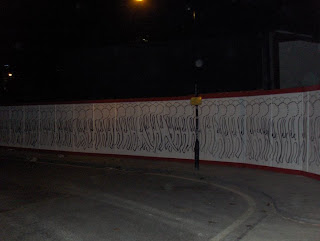
-essentialy an 'urban hack'(see or google Scott Burnham) UWS suggests a more spatial and volumetric consideration of the urban wall and the potential of 'guerilla gardening' as an integrated urban/architectural intention rather that merely being flowers on the ground.
-I consider this an urban hack as it uses existing poster space and literally takes that material, slices it up and reconstitutes to create something new that jams the space from more ads to appear. It's an interesting, i guess, jiu-jitsu move that uses the energy and motivations of another urban system and distorts its mechanisms for something else. Although I make mention of 'guerilla gardening' i see this project more of a hack as it reveals the potentials and provocations of urban space rather than beautifies or greens the space--it offers a new perspective of interpreting urban objects and space. Admittedly, most of these plants will be pretty dead pretty soon-- I don't cry over them, although future UWS will consider more Succulent plants for installation.

- interesting variations, as above, were/are being collaborated with artist DSMartindale where a more graphic intention is being sought. Here, a cork or striped effect is created and the use of the conical shape both follows this graphic intentions as it furthers the act of 'peeling' away the poster space. Further, the conical shape creates an interesting funnel that allows aeration to occur without having to punch holes in the bottom and, in the corkscrew pattern, allows water to naturally flow from one planter into the other. It's a nice functional aesthetic!


- on a process note, i quite like how well this idea simply flowed from sketch to realization in a very short period. although, having looked at my previous 'Natural Urban Intervention' work, I realize this probably builds and was influenced by that work; that is, I'm currently quite interested in our interpretation of the natural in contemporary urban design and recontextualizing natural elements to offer wry, delightful moments that ponders the amount of 'control' placed on urban design. None the less, I enjoyed the sketch model making and notebook sketches that describes a relatively simple idea but, considering the planter contextually, allows it to be a provocative moment.
- i''m calling it UWS or Urban Wall System as it seems like a politeful jab to my architectural background--that there would be these, *ahem* pretentious designers with willfully demanding intentions of urban design control where as this 'system' is really more of a hacking of existing space and really, in its own delightful way, organically forms its own geometries... . I guess also UWS suggests a more interesting or at least provocative way of dealing with derelict streetfront space...
- I enjoy how this project follows on the heels of the 'Post No Bills, Post Pretty Art' project in Edmonton at its optimistic intentions of taking dead or repetitive spatial experience and give a more 'eventful' moment than repetitive visual graphic that often occurs on hoarding or abandoned storefronts.















